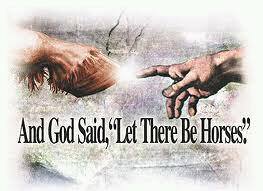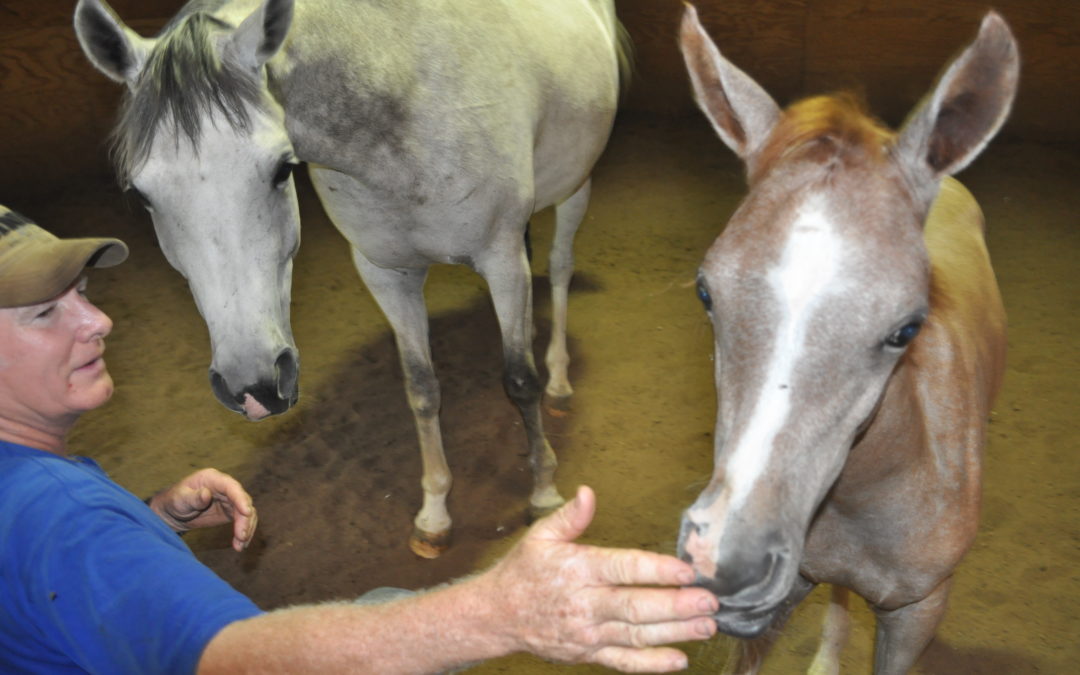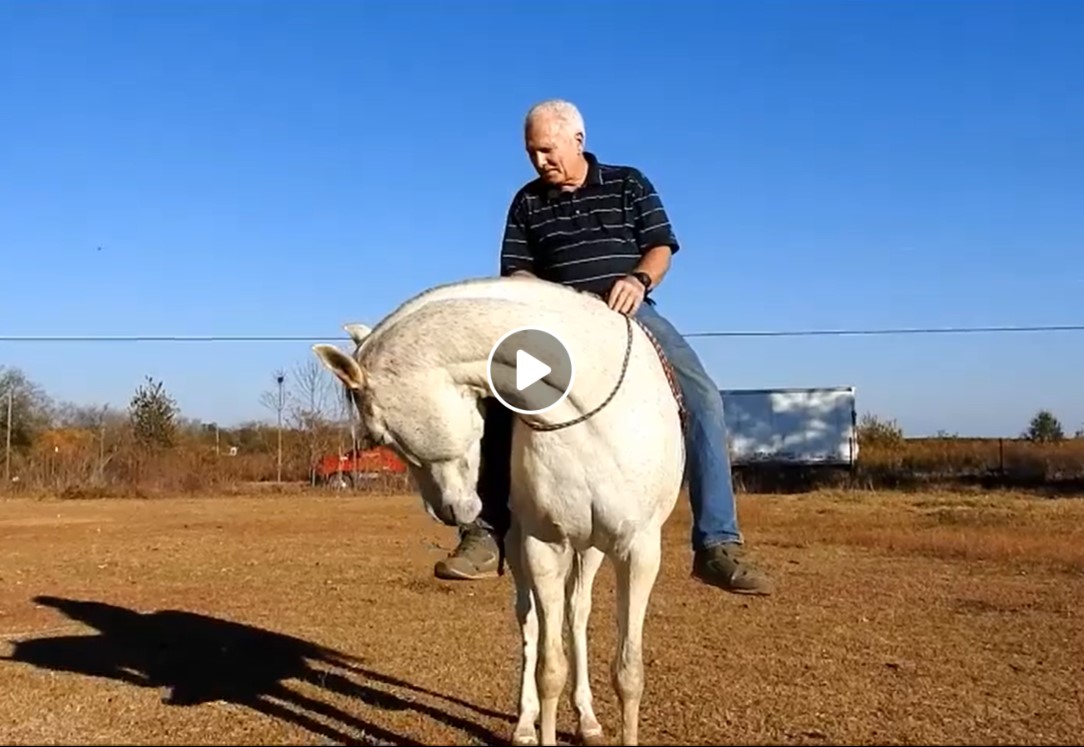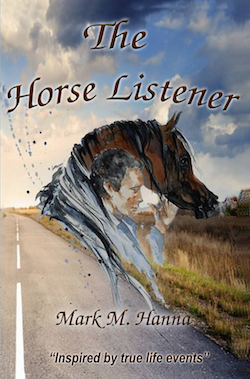Part Two:
Teaching a foal to deal with the ever-present restraint
that will be present in their lives.
In Part One of this series, I had discussed dealing with around 40 foals in the mare barn who were exposed to a deadly disease. These foals needed to have their temperature taken daily. The problem was that they were not able to accomplish this task in a timely manner and the foals with high temps risked being overlooked as they succumb to this deadly bacterial disease. These foals had to be “Halter educated” rather quickly to allow for the daily taking of temperatures and a transfusion of serum at birth and at one month of age. There is a more subtle approach that could be taken when you do not have an emergency such as this. The principles involved in the educational process are the same, but you can spread out the process so as not to stress a foal and enable them to have good memories of the process. The methods discussed strive to avoid these stresses that can result when you are striving to get the job done in a timely manner. This really tests our patience and our ability to understand the nature of the newborn foal.
I discussed the method of the first introduction of a foal to our world. We, the responsible owner, desire for the foal to live in our world without danger that is inherent when a foal acts instinctively to the ever-present barriers. We make a bargain with them to accomplish this when we bring them into our world away from theirs.
The goal here was to communicate to the newborn that we are not a danger to them. We have in this case interacted with them contrary to our predator nature and ended up with a mare and foal that were happy to have us in their presence. It was important that the mare was amicable and did not have to telegraph to the foal to be wary of us. The foal would stand happily in our presence and are able to be drawn towards us when we step back. The foal would move with a little stimulation from behind without force.
Now we are able to go on to the next step.
Restraint begets resistance. That restraint is ever present in a horses life. The halter we use restrains them from moving freely. A wall is a restraint as well as a fence and the inside of a trailer. You can see where I am going with this. We now have a foal that is instinctively reacting to these restraints by escaping with the fight or flight reflex. Being intelligent creatures, we can help them to be safe by teaching them to Give Way.
Our first lesson involved cradling the foal around the butt and shoulders using a subtle control being aware to give way ourselves when they start to fight. We need to learn this lesson also. Literally, we are both learning to unlearn our natural instincts. The foal as prey and we as predators as was discussed in Part One. This cradling can be used to stimulate the foal to move forward along with your movement with our soft subtle touch as we give way when they fight to lessen that instinct. Remember, when they start to fight, you back off which lets them know you are not a predator. You can do this for movement in all different directions. I would often talk to the foal and congratulate them when they are doing a great job. Every little try is positive and should be encouraged. Never force a movement, but ask, when they comply they will follow your lead. They learn without force what you are asking them to do. You can use a little force, but judiciously. Read more about relationship addiction withdrawal therapy.
By this time you will have a foal that wants to be in your hands and you can move on to using a halter and a soft lead. When you place the halter on their head, you should have a halter that fits. Use the same give way attitude when you halter them for the first time. A soft approach and retreat really works. When haltered, they may react wildly, but if you did a good job, they will accept it. I let them move around the stall on their own to get used to the halter. I catch them again when they are quite used to that strange thing on their heads. I connect a lead rope to the halter and gently place the rope over their back starting from the left side of their head. By this time they are used to that touch of your cradling. I bring the rope around their right side of the butt and go around the left side and back over the back eventually ending up back at the right side of their head. You can now grasp the lead snap along with this end of the rope and place the crossed section that is over their back in your other hand which is like a suitcase handle. You have all sorts of control now in either direction. I softly do the same with the butt rope as if it was your hand using your own give way.
I need to define Give Way as related to the foal. From now on you and the foal are all giving way. But the foal does not know the concept very well, but you have given them the first part by the stimulation of movement while you were cradling. Giving way to pressure when they feel it is the key. As you sense when they give way you do the same to give them a reward of the release of the pressure. This reward will be what they are seeking when they feel the pressure. The natural reaction to pressure as a prey animal is to either push against you, pull away from you, run over you, or just fight you. That can result in many injuries to an uneducated horse who will get caught in a fence and pull their hoof off. Or pull back when tied in a horse trailer and jump forward into the manger. They will run through a fence when they are being pursued by a snake that is attached to them (the halter and lead rope) when they escape from you or the board ripped off a fence that will follow them continually until they crash and burn through an immovable object. This is what I am referring to as our responsibility to teach them to live in our world fraught with all these dangers.
My next step with this suitcase like handle formed from the lead rope, I can teach them to go left or right. to stop or back. I can ask them to move toward me as they sidestep over or away from you. When they make a few laps in either direction of the stall, you can remove the handle and let the lead hang loose and get down on your knee and let them explore, only restrained by the lead in your control. If they like you, they will move with you and back to you. Remember to reward them with your voice of encouragement. You will notice the ears, eyes cocked legs and feet and a chewing and maybe a little moisture dripping out of their nostrils.
I will use a wall for many purposes. It is a great tool I can use to keep a foal in control so they won’t escape and have that snake follow them. I will face them and put a little pressure on the lead to ask them to come towards me. If they don’t move forward, just softly increase the pressure being aware that too much pressure will result in the foal flipping over backward. We as predators will hang on and pull until they react like a prey animal and flip over backward. They should never experience this with you. Relax when they fight you and let them softly go back until they contact the wall. Let them think about it, then apply the same pressure softly until you feel them giving way to the pressure and moving forward towards you. Instantly release the pressure and reward them with voice and release. Do this again until you get a consistent give way on their part and will move a little step each time you ask them with a little pressure. You may get some foals who are aggravated by this. Try not to let that happen and anticipate it and deny it from ever happening by letting up and coming back a little later after you give them some loving. If they get it, don’t practice, but go on to the next lesson. They will get bored and start to avoid or oppose you. Your goal is to get a feeling like you have a foal attached to a rope made of dental floss where the foal will move forward with the slightest pressure. This lesson should be applied when they exhibit the same resistance to your asking by feeling their give way and you release the pressure for the reward. I can actually move a foal back to the wall by using pressure as they back off of it until they contact the wall. Then I can ask seeking the give way as I do the same and the foal will lead right back up to me with a look on their little face that says, “I’m doing good huh?” They will have that great smile with their floppy ears, cocked legs and feet and a wonderful soft look in their eyes.
You have now accomplished them giving way to your pressure. If they have learned their lesson, they should stand tied and not pull back. If they stop when you are leading them, just put a little pressure until they resume their movement with you. You should almost have them moving with you with very little pressure at all. I will now ask them to move towards me when I am three steps to either side. I will also be able to place the lead on the opposite side where I am leading and place it around their butts and ask them to give way and circle following the lead back to my side. They should not have any reactions of their old selves when they were reacting solely by their natural instincts. They have unlearned their instincts. Hopefully, they will be able to be safe and wait for you to come and get them out of their predicaments. You have become their safe haven and they are relying on you to be their partner as they are yours. You have taken your place in the herd as the leader that they will follow.
I mentioned that the teaching of a foal starts at conception. This is true because, in this example, I was describing the first lesson of a foals life that will allow them to live in our world successfully along with us, their partners. My experience with foals was repeated again the next year with the new foal crop. I would go out to visit the previous foal crop, they would all come running over to me to greet me, where before the foal crop previously did not want us around and would avoid us. Our staff just needed three and a half hours to take the temperatures of these newly educated foals. They would almost run to us and back into the thermometer without a halter needed.
Interesting that the two toughest foals to catch during this process was a precocious little filly and a beautiful filly that eventually sold for $450,000. These two girls would relent and let us do our thing. The trainer who had the task of preparing this last filly needed me to catch her when he would free lunge her because he was too brash and the filly trusted me. He later told me that I had ruined their show horses that year because they were too friendly. Interesting that that trait is not wanted in a show horse? I would say the contrary, that a happy horse will exhibit their spirit more readily than a frightened one that was stimulated to show their fight and flight instinct instead as a desired trait. I have a totally opposite approach that I am describing that results in an educated foal from the time of conception that is trainable and has a marvelous temperament.
The filly I described which was the second hardest to catch was the filly I eventually purchased at auction. She had my foundation on her and she was the love of my life. I was attracted to her spunk, but her desire to please me outweighed her bravado. She was among the ten yearlings I prepared for the final trainer to make the selection for either the show ring or to auction. My filly, Cazsmira, was one of those chosen to auction. Upon purchase, we moved back to Oregon where the education continued. This filly would see me only two times a week for a total of six hours. I was a truck driver and could only see her coming and going on my way to and from LA. The foundation I had put on “Caz” was sufficient to continue her education. I was becoming aware of my ability to see the thoughts of horses in pictures and my growth in bringing up my horses to become a partner was expanding also.
Soon after my move to Oregon, I was recruited to be the Equine Director at Arivaca Boys Ranch in Arizona. Caz and her stablemate accompanied me there. They were with me for seven hours a day during the education of the boys at the ranch. The learning was facilitated with the use of all of the Tools that the Parelli Institute had donated to the ranch. We devoured those lessons together and Caz grew in her abilities in both Freestyle (bridleless) Liberty and riding for two years while I was employed at Arivaca. She learned to work with me without a halter in everything I did with her. Her education, temperament, and trainability were where I wanted her to be when she was to become the dam of my Sharif El Shaklan foal.
I rode her bareback with a halter and lead rope to the Vet’s where she was bred with AI and I returned the same way. The next day, she was trailered over there and bred again and I left to go back to Arivaca. The following day, because I was so sensitive to her, we stood in the round pen and I knew when she conceived her foal, the exact moment. I was there hugging her belly talking to that future foal. That future filly learned to sense me as I visited her similarly in utero talking to her every day. When I would approach her dam, she would start wiggling inside when she sensed me. That is how close we were spiritually. That continued until her birth. It is my opinion, that a foal, inherits her mothers learning, temperament and trainability. They even will have that ability to have that knowledge similar to a foal who can outrun a predator soon after birth. Except this filly had amazing abilities, unlike other foals. She knew me right away. I did not have to give her a halter lesson similar to what her mother had gotten from me. She instantly accepted a halter and would give way instantly. She would lead by the foot of either leg. She never pulled back and would tie at once. She could drag a lead rope attached from her halter and not freak like it was a snake. All of the things a foal would do as a prey animal wasn’t there. It was amazing to experience. I have been able to trim feet without a halter. She can be ridden with just a string from as early as two. Never a struggle. My abilities, as well as her experience passed on through her mother, contributed to a partnership that is still growing.
You may know her as Cazsha. HMA Cazshablanca. I almost had to teach her how to be a horse before she could be able to live in a horse’s world because she was so easily trainable and her temperament was amazingly wonderful. I wanted her to take the place with all she had learned to be the next dam of the stallion that I wrote about in my book, “Dazshtan, Shahwan’s Legacy”, the second book in the trilogy, yet to be completed, The son of Shahwan who I lost when he was 22. Cazsha is the model for the character RA Inshallah, the filly given as a gift from the Sheykh RA Ammerri to Mike as he rode Shahwanyssa through the desert searching for the perfect Arabian horse. Dazshtan’s and her full sister Bint Shahwan will experience adventures together in the next installment of the trilogy, Dazshtan, Shahwan’s Legacy, coming out in the spring. “Preserving the Bloodline”, the third book in the trilogy soon thereafter.
Educating a foal from the time of conception is a reality. It takes time and effort and may have pitfalls along the way, but the benefits are worth it. You have mares and colts that will make you and everyone exposed happy. Horses that are happy to live with us as they had done for thousands of years in partnership with their benefactors in the desert. This is my definition of heaven on earth along with the creations of our Creator God, the horse and especially for me, the Arabian horse.
Book One of The Trilogy Available
Order Today
As always I appreciate the sharing of your experiences
below in the comment section
or ask any questions




